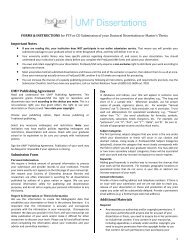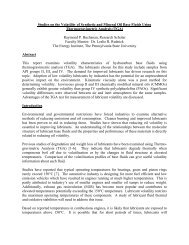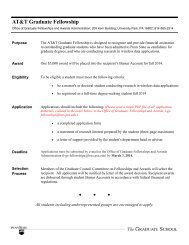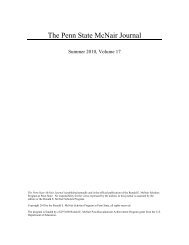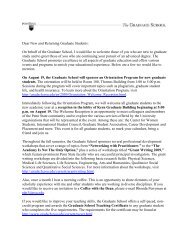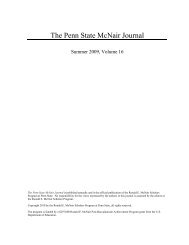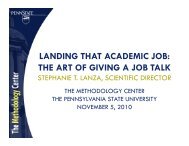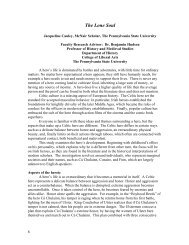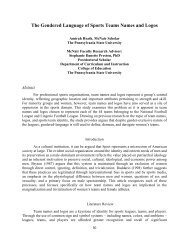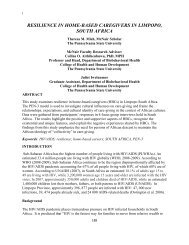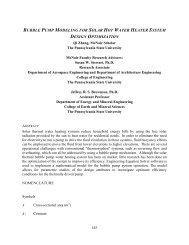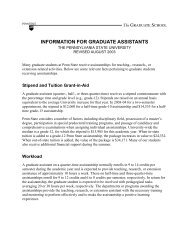1 GRADUATE COUNCIL MEETING 18 January 2012 102 Kern ...
1 GRADUATE COUNCIL MEETING 18 January 2012 102 Kern ...
1 GRADUATE COUNCIL MEETING 18 January 2012 102 Kern ...
Create successful ePaper yourself
Turn your PDF publications into a flip-book with our unique Google optimized e-Paper software.
Master of Science Degree in Engineering Science and Mechanics (M.S., ESMCH)<br />
Program CHANGE Proposal<br />
Page C4<br />
Introduction and Program Statement. The Engineering Science and Mechanics (ESM) Department is in the process of revising its<br />
curriculum. The range of research and educational expertise amassed by the ESM faculty has grown over the past several years to<br />
encompass bionanotechnology, biophotonics, and neural engineering in addition to advanced materials, electromagnetics,<br />
nanotechnology, and mechanics. With increasing collaboration across the boundaries of engineering science and mechanics, the ESM<br />
faculty voted to unify the two separate M.S. degree granting programs into a composite Master of Science degree program in<br />
Engineering Science and Mechanics (M.S., ESMCH). The new designation will also align with the department’s Ph.D. program,<br />
which offers the Ph.D. degree in Engineering Science and Mechanics (Ph.D., ESMCH).<br />
The ESM department also offers two integrated undergraduate/graduate degree programs, which will be collapsed into a single<br />
program offering the Bachelor of Science degree in Engineering Science (B.S., E SC) and the Master of Science degree in<br />
Engineering Science and Mechanics (M.S., EMSCH). [It should be noted that there are no changes to the undergraduate component<br />
of the IUG program. Moreover, there are no changes to the structure of the IUG program in that credit requirements, allowances for<br />
double-counting of 12 credits (which are not prescribed and only 6 of which may be 400-level), and all thesis guidelines remain the<br />
same.]<br />
The unified degree program recognizes this interdisciplinarity with a breadth requirement, whereby all students will take one course<br />
each from categories designated Mechanics, Materials, and Engineering Science; the remaining course work can be tailored to suit the<br />
student’s educational objectives and research interests. The composite degree will enable our M.S. degree candidates to graduate with<br />
a breadth in mechanics, materials, and engineering science and with a concentrated program of study in mechanics, materials, or<br />
engineering science.<br />
We have generated a series of co-dependent proposals to achieve the desired end result. The IUG proposals (proposals 3 and 4 in the<br />
list below) will be submitted separately for review by both Graduate Council (graduate proposals) and the University Faculty Senate<br />
(undergraduate proposals).<br />
1. Drop the M.S., Engineering Mechanics Degree Program.<br />
2. Change the M.S., Engineering Science Degree Program to a composite M.S., Engineering Science and Mechanics<br />
(M.S., ESMCH) Degree Program.<br />
3. Drop the Integrated Undergraduate/Graduate Engineering Science (B.,S., E SC) and Engineering Mechanics<br />
(M.S., E MCH) Degree Program.<br />
4. Change the Integrated Undergraduate/Graduate Engineering Science (B.S., E SC) and Engineering Science (M.S., E SC)<br />
to the Integrated Undergraduate/Graduate Engineering Science (B.S., E SC) and Engineering Science and Mechanics<br />
(M.S., ESMCH) Degree Program.<br />
This proposal addresses the composite Master of Science degree program in Engineering Science and Mechanics. Students pursuing<br />
an M.S. degree in Engineering Science and Mechanics (M.S., ESMCH) must complete 32 credits and write a scholarly thesis.<br />
A. Program Requirements. A revised version of the affected area showing both the old program requirements and the new<br />
program requirements (so the reviewers can determine what specifically is being changed). The proposal should include a<br />
side-by-side comparison of entry requirements, number of credits required, specific courses to be taken, etc. A copy of the<br />
revision to the Graduate Bulletin text must be included, and the proposer is requested to use underlining, bolding, or italics<br />
to indicate changes.<br />
• Master of Science Degree in Engineering Science and Mechanics (M.S., ESMCH)<br />
Objectives. The objectives of the M.S., ESMCH degree program are to: 1) provide an interdisciplinary curriculum, while<br />
retaining the ESM Department’s core strength in mechanics education and research; and, 2) interpret mechanics in its broadest<br />
context to include biomechanics, celestial mechanics, computational mechanics, fluid mechanics, quantum mechanics, solid<br />
mechanics, statistical mechanics, structural mechanics, and wave mechanics, among others.<br />
Engineering science promotes the interchange of ideas across all branches of the scientific and engineering disciplines from both<br />
theoretical and experimental perspectives. Students in the composite degree program are expected to pursue interdisciplinary<br />
studies in areas that encompass nano- and bionanotechnology, advanced materials, electromagnetics, mechanics, microelectronics,<br />
nanoelectronics and bioelectronics, neural engineering, photonics and photovoltaics (among others) and they<br />
are expected to embrace multidisciplinary perspectives across departmental, College, and University boundaries.<br />
4



